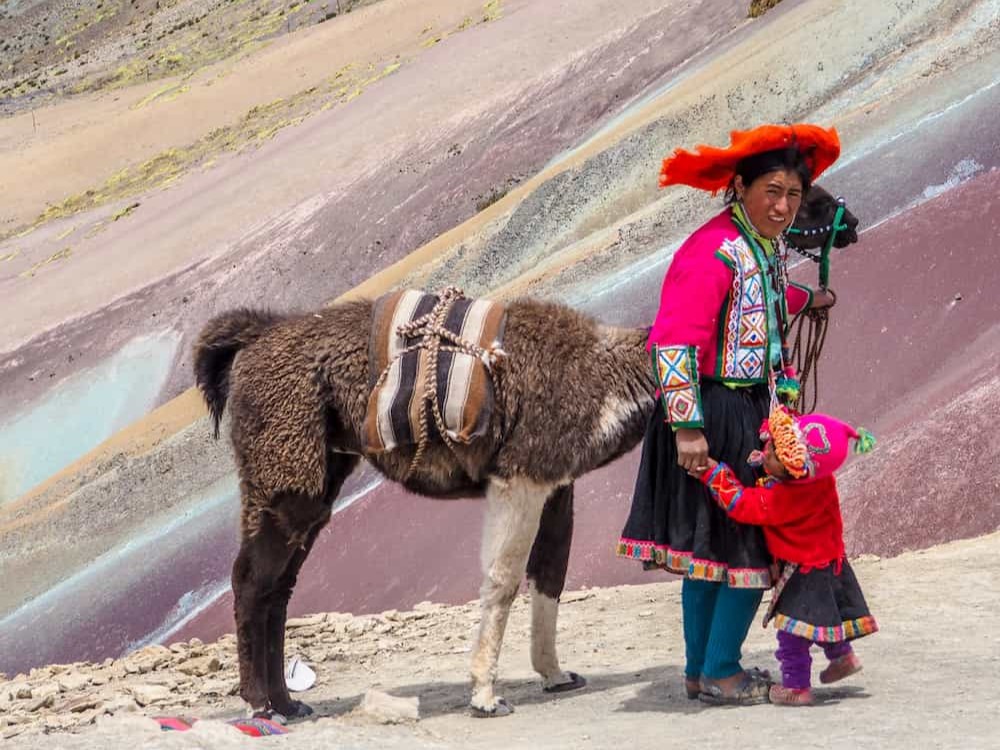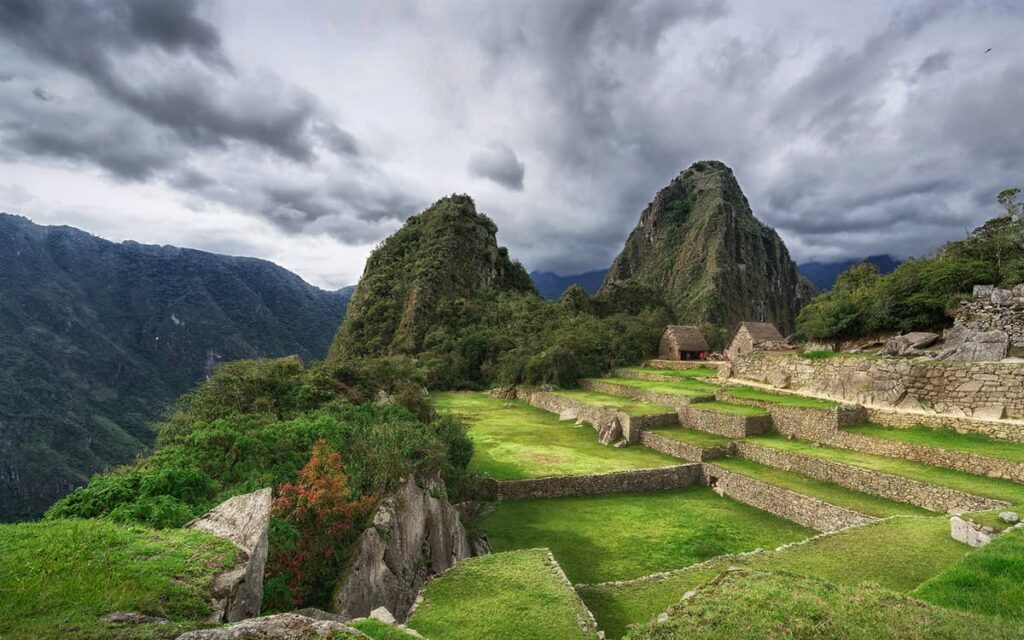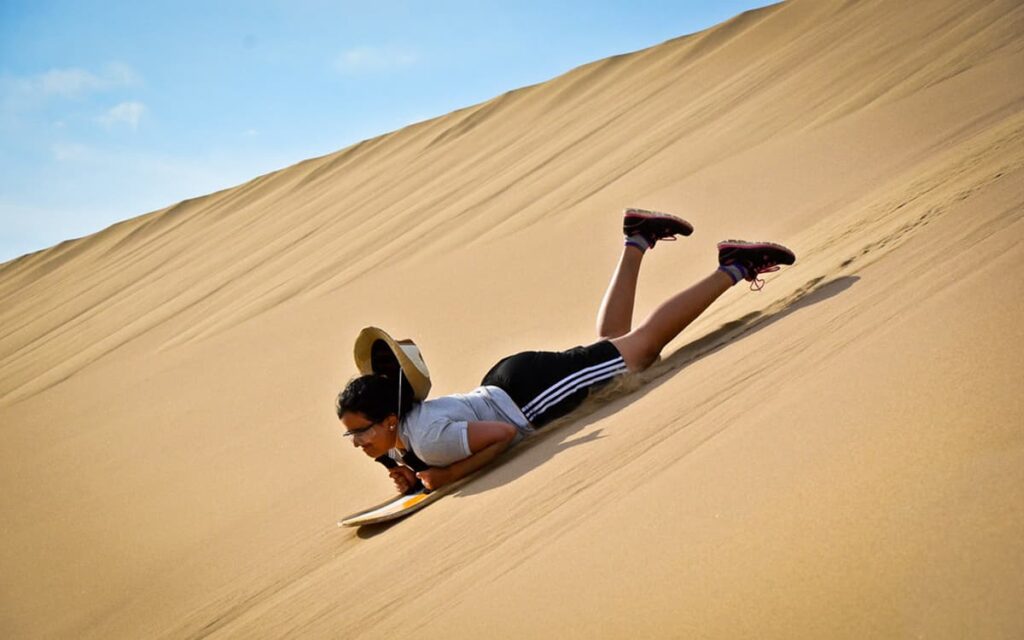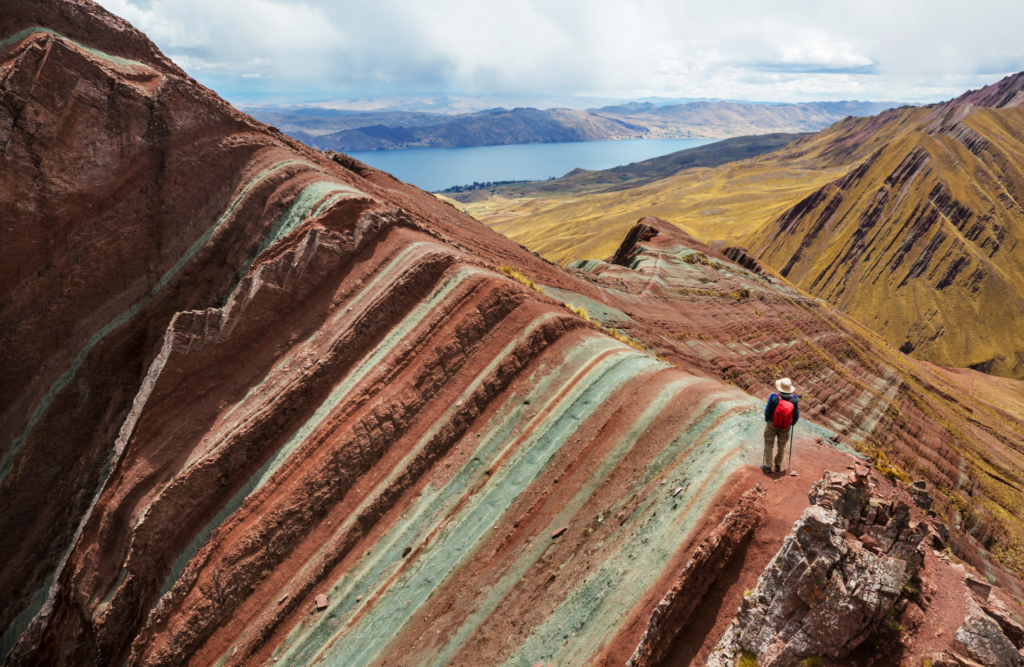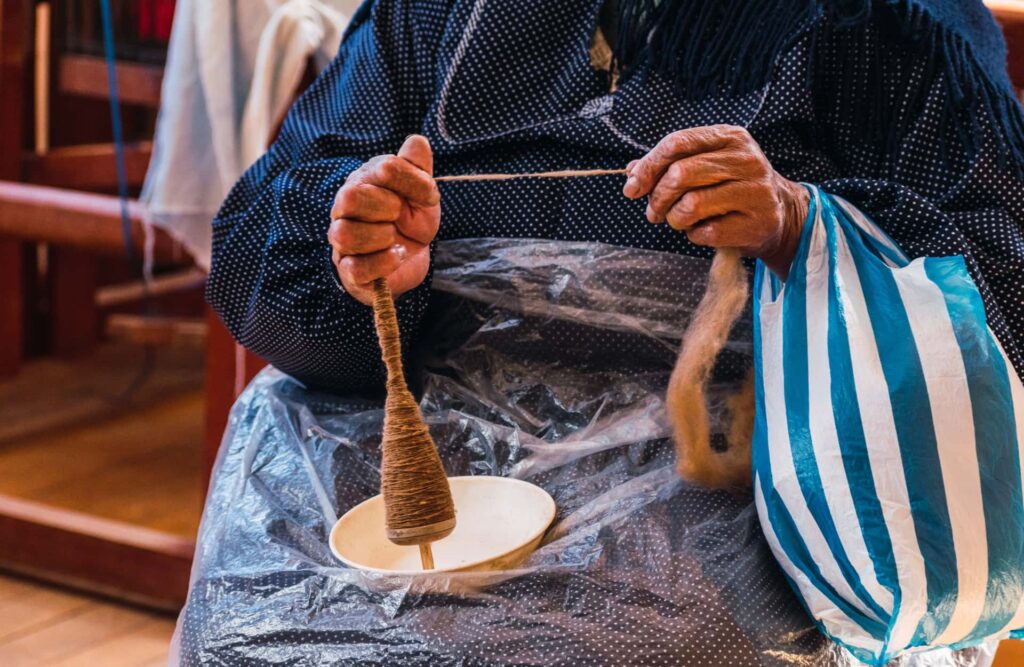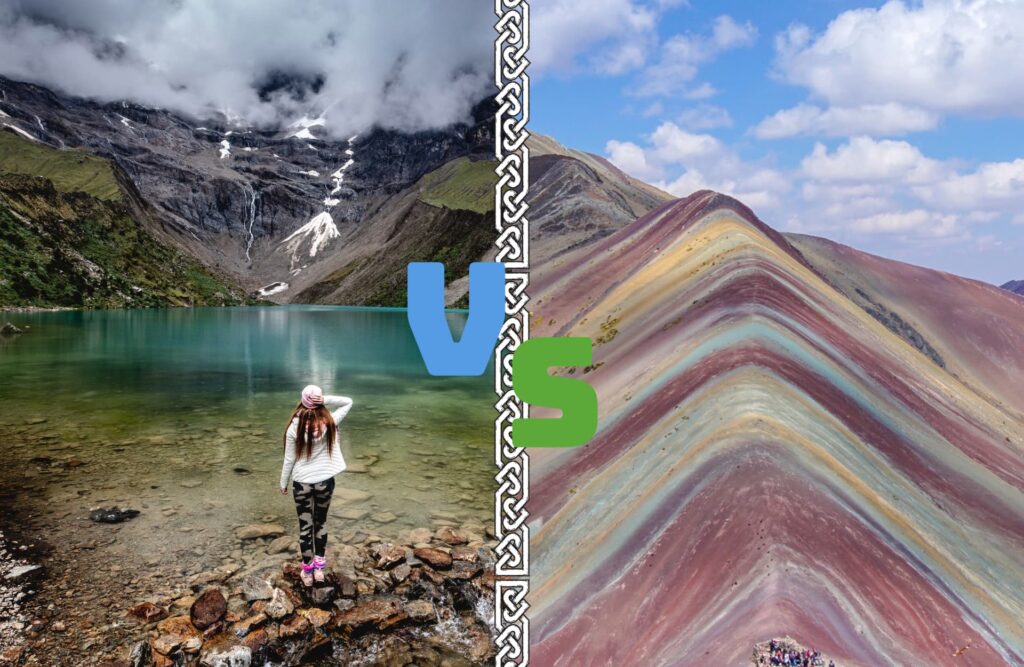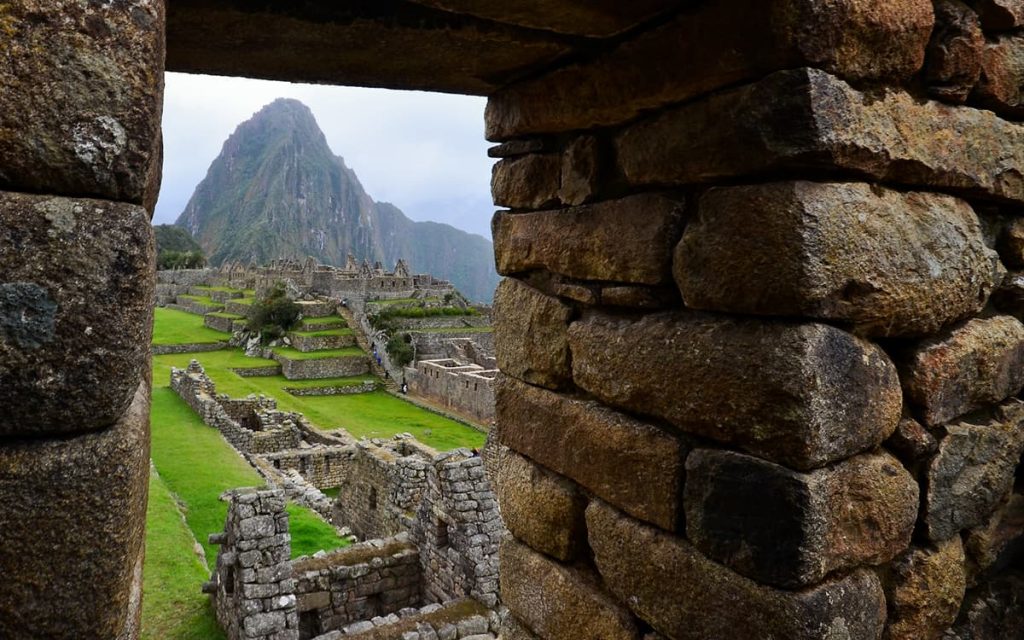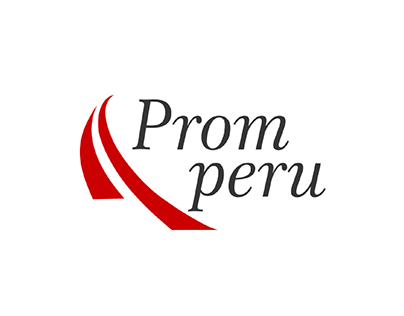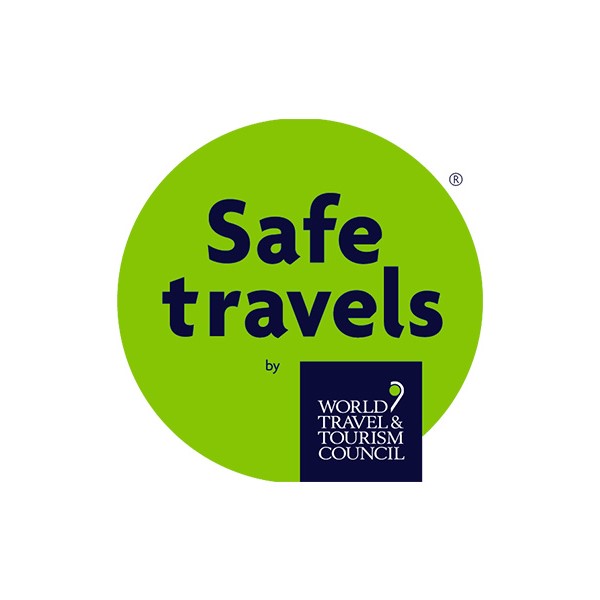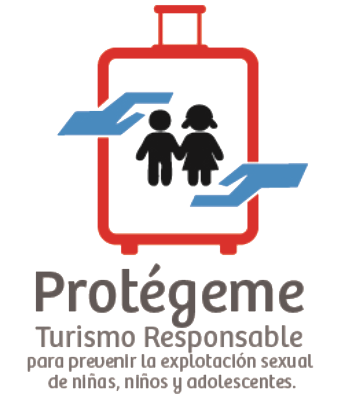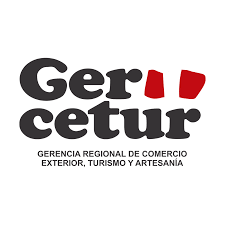Where is Ausangate mountain?
08170, Peru
Ausangate is located 100 kilometers southeast of Cusco. It is located in the district of Ocongate, in the province of Quispicanchi, belonging to the department of Cusco in the Vilcanota mountain range.
The Ausangate mountain is the fifth highest in Peru and the most representative of the Cusco Andes, its maximum altitude is 6,385 meters above sea level.
- Latitude: 13 ° 47 ’18’ ‘S
- Longitude: 71 ° 13 ’40’ ‘W
Meaning of Ausangate
Ausangate (Awsanqati in Quechua) means «copper».
Among the Apus or Andean mountains, the Ausangate rises imposing, and is admired not only for its extraordinary beauty, but also respected for what it means for the Cusco worldview: a sacred snow-capped mountain.
How to pronounce Ausangate?
To help you pronounce the word “Ausangate”, here’s a breakdown of the word Ausangate how to say it:
OW-san-got-eh
History of Ausangate mountain in Peru
The Incas believed that the masculine energy that fertilizes Mother Earth (Pachamama) was born from this mountain and the surrounding lakes. According to them, the waters entered the unexplored lands of the Amazon to re-fill the lakes and glaciers at night and become a river of stars that would be what we know as the Milky Way.
The legend of the Ausangate and Salcantay brothers
Inca tradition tells that Salkantay and Ausangate were two brothers who lived in Cusco. After a terrible dry spell, the two ventured into strange lands to save the town from crisis. Salkantay left for the north and found the jungle, and there, Verónica’s forbidden love; Instead, Ausangate went south, to the highlands, and in that place he found a large quantity of Andean food, such as camelid meat, corn and potatoes, which he sent to the population.
The Chillca community, made up mostly of llama and alpaca farmers and herders, is known as the guardian of these beautiful places. Every year on the slopes of the mountain the festival of Qoyllur Ritti – «star snow» in Quechua – is celebrated before the Corpus Christi festival, during which thousands of people make pilgrimage to the Sinakara temple where the painting of the Crucified Christ engraved on a rock. This pilgrimage has been named Intangible Cultural Heritage of Humanity in 2004.
The First Expedition to Ausangate
Since the first expedition in 1950, under the command of the Italian Piero Ghiglione, many explorers and hikers have tried to conquer the Ausangate Summit. It was not until three years later, when a German expedition achieved the desired goal by climbing the mountain on its southern slope. Later, new routes were opened to make the ascent more bearable and less difficult.
Ausangate Nowadays
At present, different companies have been promoting the Ausangate trek in Peru, that one, has among its purposes that the expeditionists manage to surround the snow-capped mountain, although still to date, few experienced visitors have dared to follow it. Those who are interested in climbing this snowy mountain, have to know that they must have had enough time of previous practice since the Apu, is not a snowy for beginners; so if you are an intermediate level mountaineer, it is recommended that you go in the company of a larger group of people experienced in the field.
This snow-capped mountain is also important on a tourist level, due to the festival in honor of the Lord of Qoyllur Ritti (Quechua: «star snow»), a Christian-Andean celebration, which takes place at the foot of the snow-capped mountain during the months of May to June and which venerates the Christ of the rock that appeared in the year 1780. This pilgrimage was included in the Representative List of the Intangible Cultural Heritage of Humanity.
Ausangate Glacier
Ausangate is the fifth highest mountain in Peru, measuring 6,384 meters above sea level (masl).
Ausangate Mountain in Peru is considered an apu, or protective deity of the surrounding towns; as well as the most representative mountain in the region. Its size is such that it can be appreciated even if one is in the Sacsayhuamán Fortress, not in vain it is considered the fifth highest mountain found in Peru.
This beautiful Cusco snow-capped mountain is impressive to the eye, due to its incredible natural formations; In that area there are not only beautiful water bodies such as Sivinicocha, with turquoise waters, but also stone forests, glaciers and high plains that seem to make this natural attraction a paradise on earth, especially for those tourists who are interested. for adventure sports since, the geographical accidents of Ausangate make it ideal for practicing sports such as rock climbing, ice climbing, trekking, among other activities.
It is a very attractive place for people who practice adventure sports, thanks to its geographical accidents it is possible to practice climbing and trekking.
Ausangate Summit
Its main summit is 6,384 meters above sea level with large lagoons with a luminous green / blue color.
Reaching the Ausangate summit involves a journey of 5 days and 4 nights along 70 km, which is why it is considered one of the most challenging trekking routes in the Andes. However, during the Ausangate hike in Peru, the traveler witnesses incredible postcards: multi-colored mountains, herds of alpacas and desert cliffs that together create an incredibly beautiful outdoor experience from start to finish.
Ausangate Hot Springs
The Ausangate hot springs or thermal waters of Pacchanta is the ideal place to spend a weekend in the company of family and friends.
Entering the hot springs after having completed the Ausangate circuit in Cusco, it is necessary. Here you can relax and have a good time with family or friends. In the case of taking the tour, it is recommended to be with the group to avoid setbacks when getting ready to leave for Cusco.
Where are the Ausangate Hot Springs located?
The thermal waters of Pacchanta are located at 4200 meters above sea level. on the slopes of the fifth highest mountain in Peru, the Ausangate. Approximately 100 kilometers to the South East of Cusco, in the district of Ocongate.
Ausangate Hot Springs Elevation:
Pacchanta is located at an altitude of 4200 meters above sea level.
Pacchanta Town and its Hot Springs
The town of Pacchanta is located at 4,200 meters above sea level on the slopes of Ausangate Peak. It is a small town with highland customs. The inhabitants of the place make sure that your stay in the hot springs is unforgettable.
In front of a couple of adobe buildings are the Pacchanta hot springs. In fact, maintenance has recently been done for new visits. Around the town, we can observe the presence of animals such as Andean camelids, toads, frogs, and other animals of the place.
The waters that reach the thermal baths, evoke the Ausangate Peak, this is considered as the Apu Ausangate. Likewise, the people of Pacchanta know him affectionately as the «Creator of the waters.»
The thermal waters of Pacchanta have some pools of water, whose temperature varies between them, from hottest to coldest. On one side of the hot springs we can find changing rooms for women and men. Also, we will find toilets for the use of visitors. In the case you want to keep your belongings, you can do so by placing them in the lokers located at the bottom of the medicinal waters.
How to get to Ausangate Hot Springs?
The time it will take us to get to the town of Pacchanta from Cusco will be approximately 3 hours. There are two routes for this:
Long Route: Cusco – Chillca
For this first route, you must take a bus from the city of Cusco to the town of Chilca. Once you are in the town, you will walk between 4 to 5 hours until you reach the town of Pacchanta. Where you can enjoy the medicinal waters.
This first Ausangate circuit route is the most adventurous because it is the longest and not very economical. Since you will have to go climbing to reach the town of Pacchanta. However, you will enjoy the scenery.
Short Route: Cusco – Tinki
As a second Ausangate circuit route we have the goal of getting from Cusco to the town of Tinki by bus, the average travel time from Cusco is approximately 3 hours. Once we are in this town, we must take a bus to reach the town of Pacchanta. This second option is the most economical and practical at the same time.
How to get to Ausangate Hot Springs with a Travel Agency?
As a suggestion, in the case of wanting to do the trekking without worries or setbacks, it is recommended to hire the services of the tourist agency of your choice. Take into account that, when hiring the services of an agency, you will not only visit the hot springs of Pacchanta but also have options to choose an additional tour such as the circuit of the 7 lagoons of Ausangate. Here is the link to the main page of Inkayni Peru Tours.
Entrance tickets to Ausangate Hot Springs:
The cost of entering the thermal waters of Pacchanta has a symbolic price of S/. 5 soles or $ 2 dollars per person. In the case of wanting to buy some food, it is suggested to collaborate with the residents, who have small stores with everything you need. They will be delighted to receive you and provide their services, in the same way we always suggest respecting the lifestyle of the people of Pacchanta.
When is the best season to visit the Ausangate Hot Springs?
As we know Cusco has two well-defined seasons, the rainy season that begins in the month of November and ends in the month of March. Meanwhile, the dry season begins in April and ends in October.
So, the best season to travel in and out of Cusco is during the dry season. Because the presence of rain is minimal during these months of the year. However, it is recommended to provide warm clothing in case you arrive in Cusco between the months of June, July and August, as they are the coldest and windy months.
What to pack for Ausangate Hot Springs?
Next, we will share a small list of things that you should not forget to pack to get to the hot springs of Pacchanta, Ausangate:
- Towels for body, face, hair
- Swimwear
- Flip flops
- Shampoo
- Toilet soap
- Creams
- Combs
- Extra knot of clothes to change
- Hats and sunscreen
- Personal documents
- Make sure your backpack is as light as possible
- Don’t forget to bring a camera and take lots of pictures for your scrapbook
- In the new normal, it is recommended to wear a mask and face shield at all times.
- Stay away from other people at least 2 meters away.
7 lagoons of Ausangate
If you are more than tired of seeing the same in Cusco, we encourage you to visit the 7 lagoons of Ausangate, a full day excursion full of adventure, landscape, mountains, lagoons of turquoise, blue, green and even reddish color; You can also see a bit of the Andean flora and fauna (Alpacas, Vizcachas and Condors).
Name of the 7 lagoons of Ausangate:
- Blue Lagoon Cocha
- Otorongo Lagoon
- O´Quecocha Lagoon
- Puca Cocha Lagoon
- Q´omercocha Lagoon
- Murococha Lagoon
- Alqacocha Lagoon
Where are the 7 lagoons of Ausangate?
From the city of Cusco more than 100 km to the south east, there are the 7 Ausangate Cusco lagoons. In the jurisdiction of the province of Quispicanchis district of Ocongate.
Why are the 7 lakes of Ausangate turquoise?
Some of the 7 lakes of Ausangate have a turquoise green tone in color, that is what makes them attractive, because the water coming down from the snowy peaks also brings pulverized minerals with it and finally they end up super-swimming in the waters, without submerging at the base of the lagoon, in this way, on sunny days, the effect of the coloring will be better appreciated.
Flora and fauna
Because it is a walk through the natural region «Puna», you can naturally appreciate the fauna that characterizes these regions with the hundreds of Alpacas, llamas, sheep among others in their natural habitat. On the other hand, the abundant Ichu (Stipa Ichu) will be lying on the entire slope, and by the deserts of the puna with wild herbs, which grow only at ground level, due to the type of climate at these heights. Also from time to time some birds such as the great huallatas (chloephaga melanoptera) and others will be chirping near the lagoons and flying over occasionally.
How to get to the 7 lakes of Ausangate?
Pacchanta Route – just one day.
This route is the shortest¸ the objective is to reach the community of Pacchanta at 4300 meters above sea level. Place where the walk begins. As you advance along a puna path, dotted with gravel and pebbles, flat at first, the first lagoons will appear. When you go up to the top, there the panorama is the best one can imagine, with the snowy peaks so close in front and the lagoons settled at the bottom and still when turning back the mountains in the distance disappearing in the horizon.
Upis Route – two days.
The objective for this walk is, to reach Upis which is only a few kilometers from Tinki. The walk begins at 4200 meters above sea level, on a relatively flat road. The distance to be covered during the first day is approximately 7 KM. with a drop of 200 meters, until reaching the Upis camp 4400 meters above sea level. For lunch and then rest for the whole afternoon.
At dawn the next day, the snowy and multicolored fields will come to light, later a time for breakfast and at the time of the hour, the walk will have started on the second day. There will be a need to save effort because the unevenness will be higher than the previous day and the need to walk will be for more time and distance. The idea is to reach the viewpoint of the lagoons as soon as possible to take advantage of the morning sun and that the landscape from the viewpoint looks amazing.
On the descent to Pacchanta, after having seen the animals, plants, landscapes and others. By this time he may be a bit tired but there is something else waiting for him in Pacchanta, yes; Thermal medicinal waters, prepared precisely so that after a long excursion, it is a place of rest and relaxation for anyone who needs it. It is one more option. Then we return to Cusco.
How to get to the 7 lagoons of Ausangate from Cusco on my own?
From the city of Cusco you can take a local transport. Head towards Av. Tomasa Titto Condemayta and as a reference, the closed Casa de la Juventud coliseum, there will be the combis that cover the route Cusco – Ocongate Tinki.
Arriving at the final destination Tinki, prepare to continue towards route 7 Lagunas Ausangate Cusco. This is the last point where you can acquire some provisions such as Water, or some other reinforcement. If not necessary, approach any of the men who are offering transportation service.
You can deal with a taxi driver or a motorcyclist, you have to negotiate the price. The next stop is Pacchanta, you will go along a dirt road for about 30 min approx. The cost of the ticket may vary between taxi drivers. When you finally find yourself in the Pacchanta sector, ask a local for the startint point and climb to Ausangate .
How to go to the 7 lagoons of Ausangate from Cusco with a Travel Agency?
From the city of Cusco you can get there by taking an operating travel agency, now just for a moment at this point you may wonder if you can get to the lagoons independently, the answer is yes! But wouldn’t it be great to avoid a lot of details in stops, combis, motorcycles, translation problems and other details? Therefore, it is better if you arrive with a travel agency because there is no time to lose when you are traveling.
Climate
The climate factor has to be considered in the first line, let us blame the altitude because the winds, the cold and the heat of the puna will make you good company. One can find a friendly climate, but after a while this will change. The climate in these regions is constantly changing. The temperature at night oscillates an average of -10 ° C and during the day it will reach 20 to 25 ° C.
When is the best time to visit the 7 lagoons of Ausangate?
In case you dared to go, stop for just a moment, choose the months from April to November, this season is dry and you can go without many complications. But always keep in mind the recommendations of wearing adequate equipment.
Climbing routes to Ausangate
The Ausangate mountain (6398m) is considered by many road lovers, as one of the most beautiful in the Andes.
There are 4 climbing routes to Ausangate, choose the one that best suits your itinerary, time and the attractions you want to visit. Here we describe each climbing routes to Ausangate in detail:
Ausangate Tour 1 Day
- Starting point: Cusco
- Arrival point: Cusco
- Difficulty: Moderate
- Duration: 1 Day
Tourist attractions:
- Pacchanta Hot Springs
- Blue Lagoon Cocha
- Otorongo Lagoon
- O´Quecocha Lagoon
- Puca Cocha Lagoon
- Q´omercocha Lagoon
- Murococha Lagoon
- Alqacocha Lagoon
Ausangate Tour 1 Day Itinerary:
Day 1: Cusco – Tinke (3950 m.) – Pacchanta (4200 m.) – Lagunas (4850 m.) – Cusco
- Length: 10 km / 6.2 miles
- Walking time: 5 hours
- Maximum altitude: 4,850 meters / 15,912 feet
- Minimum altitude: 4,300 meters / 14,107 feet
Ausangate Tour 4 Days
The Ausangate Trek 4 days offers a true wildlife experience, and is the most challenging trek on offer in the Cusco region.
- Starting point: Cusco
- Arrival point: Cusco
- Difficulty: Moderate
- Duration: 4 Days / 3 nights
Tourist attractions:
- Pacchanta Hot Springs
- Jampa Pass
- Nevado Ausangate
- Palomani Pass
- Rainbow Mountain Vinicunca
Ausangate Tour 4 Days Itinerary:
DAY 01. Cusco – Tinki – Pajchanta (4,320 masl) – Pachaspata (4760 masl).
- Hiking length: 6 km / 3.7 miles
- Walking Time: 2 and a half hours
- Accommodation: Camping
- Difficulty: Easy
DAY 02. Pachaspata – Jampa Pass (5,010 masl) – Huchuy Phinaya (4,510 masl)
- Length: 13 km / 38 miles
- Trekking time: 8 hours
- Accommodation: Camping
- Difficulty: Moderate
DAY 03. Huchuy Phinaya – Palomani Pass (5210 masl) – Ananta (4650 masl).
- Length: 12 km / 7.5 miles
- Hiking time: 7 hours
- Accommodation: Camping
- Difficulty: Moderate
DAY 04. Ananta – Mountain of 7 colors (5030 masl) – Chilliwani – Cusco.
- Length: 9 km / 5.6 miles
- Difficulty: Moderate
- Walking time: 5 hours
Ausangate Tour 5 Days
- Starting point: Cusco
- Arrival point: Cusco
- Difficulty: Moderate
- Duration: 5 Days / 4 nights
Tourist attractions:
- Pacchanta Hot Springs
- Jampa Pass
- Nevado Ausangate
- Palomani Pass
- Ausangate Qocha
- Rainbow Mountain Vinicunca
- Open Chillka
- Yana Qocha
- Open Arapa
- Upis Community
Ausangate Tour 5 Days Itinerary:
DAY 01. Cusco – Tinki – Pajchanta (4,320 meters) – Qomerqocha (4,590 meters).
- Hiking length: 6 km / 3.7 miles
- Walking Time: 2 and a half hours
- Accommodation: Camping
- Difficulty: Easy
DAY 02. Qomerqocha – Jhampa Pass (5,010 meters) – Huchuy Phinaya (4,510 meters).
- Length: 12 km / 7.5 miles
- Trekking time: 8 hours
- Accommodation: Camping
- Difficulty: Moderate
DAY 03. Huchuy Phinaya – Palomani Pass (5,210 meters) – Ausangate Qocha – Ananta (4,650 meters)
- Length: 10 km / 6.2 miles
- Hiking time: 7 hours
- Accommodation: Camping
- Difficulty: Moderate
DAY 04. Ananta – Mountain of 7 colors (5030 meters) – Ananta – Abra Chillka (4,990 meters) – Yana Qocha (4,490 meters).
- Length: 15 km / 9.4 miles
- Hiking time: 9 hours
- Accommodation: Camping
DAY 05. Yana Qocha – Abra Arapa (4,740 m / 15,551 ft) – Upis Community (4,415 m / 14,484 ft) – Cusco.
- Length: 9 km / 5.6 miles
- Hiking time: 4 hours
Ausangate Tour 7 Days
- Starting point: Cusco
- Arrival point: Cusco
- Difficulty: Moderate
- Duration: 7 Days / 6 nights
Tourist attractions:
- Pikillacta
- Colonial towns of Andahuaylillas and Huaro
- Sistine Chapel Andahuaylillas
- Upis Hot Springs
- Nevado Ausangate
- Open Arapa
- Pukaqocha Lagoon
- Vinaqocha Lagoon
- Huchuy Punaqocha Lagoon
- Open Palomani
- Ausangate Qocha
- Jampa Valley
- Ticllacocha Lagoon
- Qomercocha Lagoon
- Pacchanta Community
Ausangate Tour 7 Days Itinerary:
DAY 01. Day 1 Cusco (3,350m) – Tinkii (3,800m)
- Length: 0 km / 0 miles
- Walking Time: 0 hours
- Accommodation: Camping
- Difficulty: Easy
DAY 02. Tinki (3,800m) – Upis (4,400m).
- Length: 18 km / 11.2 miles
- Trekking time: 9 hours
- Accommodation: Camping
- Difficulty: Moderate
DAY 03. Upis (4400m) – Arapa Pass (4750m) – Pukaqocha Lagoon (4580m)
- Length: 13 km / 8 miles
- Hiking time: 6 hours
- Accommodation: Camping
- Difficulty: Moderate
DAY 04. Laguna Pukaqocha (4580m) – Abra Palomani (5050m) – Chilcapinaya (4,650m).
- Length: 15 km / 9.4 miles
- Hiking time: 7 hours
- Accommodation: Camping
- Difficulty: Moderate
DAY 05. Chilcapinaya (4,650m) – Jampa Valley (5,000) – Pachaspata (4600m)
- Length: 13 km / 8 miles
- Hiking time: 7 hours
- Accommodation: Camping
- Difficulty: Moderate
DAY 06. Chilcapinaya (4,650m) – Jampa Valley (5,000) – Pachaspata (4600m)
- Length: 6 km / 3.7 miles
- Hiking time: 4 hours
- Accommodation: Camping
- Difficulty: Easy
DAY 07. Pacchanta (4,300m) -Tinki (3,800m) – Cusco (3350m)
- Length: 4 km / 2.5 miles
- Walking time: 3 hours
- Difficulty: Easy
Detailed 5 days Itinerary of Ausangate Hike Peru:
DAY 1: CUSCO – OCONGATE – TINQUI – UPIS
On a not very complicated day we will start the Ausangate Trek Peru traveling south of the city of Cusco and we will arrive at Tinke where we start the adventure, we will have a lunch with the view of Ausangate, and we will walk in the afternoon until we reach Upis our camping point and also We can take advantage of being able to visit the hot springs in Upis.
We start the Ausangate Hike Peru early with the pick up from the hotel at 5:00 am and we begin our adventure the first part of the trip will take us from Cusco to Ocongate where we will make a stop to have breakfast (optional) or take a hot drink and use the hygienic services after this stop we will continue to the town of Tinki 3900 masl – 12795 fasl, and then continue the Ausangate trail this will be the starting point of the hike and it will be a not very complicated day we begin at 9:30 am after meet with the part of our support team, muleteer, cook and horses which will prepare all the equipment and continue in front of us, the first part of the way will be full of local people who carry out their daily grazing and farming activities as well as Textile in the area, it will be a 3 hour walk to the lunch point at the Tinki school which is 4100 meters above sea level – 13451 fasl, where we will have our delicious lunch, at this point we will rest a bit and from this point we will have the views of the Sacred Apu of Ausangate, after lunch we will continue for 3 hours towards the next point in our Ausangate trail is the town of Upis 4400 masl – 14435 fasl. Upon arrival we will see that this town is only about 10 to 15 families that live in this sector and that most of it is dedicated to the servant of Auquénidos such as llamas and alpacas, also at this point we can visit the thermal baths or pools and take a bath afterwards of our walk.
We will have dinner and overnight at this point very close to the Ausangate peak, it will be a cold night and at a high point.
- Meals: Lunch – Dinner
- Distance traveled: 9 km – 5.5 miles
- Time: 6 hours
- Maximum height: 4400 masl – 14435 fasl
- Minimum height: 3900 masl – 12795 fasl
- Difficulty: medium.
DAY 2: UPIS – ABRA ARAPA– YANACOCHA – AUSANGATE COCHA
Second day of the Ausangate trek tour we will be able to see the lagoons and we will pass two high-altitude steps in addition to reaching Ausangate cocha at the foot of the snow-capped mountain, it will be an incredible day.
After breakfast at 6:00 am we continue our adventure to Abra Arapa at 4850 masl – 15912 fasl the first part we will hike up to the pass this will take us 3 hours of walking and will be 6 km – 3.7 miles, after to get to the pass we will continue a flat path and then we will descend towards Yanacocha at 4600 masl – 15091 fasl, where we will have our lunch next to the lagoon we will take a break and then we will continue ascending and we will have the best views of the Pukacocha and Hatun Pukacocha lagoons as well as from Qomercocha because then we have on the way 5 km – 3.1 miles, more hiking and this will take 2 hours to the highest point which is the next step of Apuchata 4850 masl – 15912 fasl then we will continue descending for 1 hour we will have the view from the imposing Ausangate to the left side and we will continue towards a new valley to the Ausangate camp point cocha at 4650 masl – 15255 fasl, where we will have dinner and camp in this majestic place at the foot of the Ausangate Peak.
- Meals: Breakfast – Lunch – Dinner
- Distance traveled: 11 km – 6.8 miles
- Time: 6 – 7 hours
- Maximum height: 4850 masl – 15912 fasl
- Minimum height: 4600 masl – 15091 fasl
- Difficulty: medium
DAY 3: AUSANGATE COCHA – PALOMANI – HUCHUYPHINAYA – JAMPA
A long day of hiking the difference in height is noticeable when crossing the highest pass in our Ausangate Hike Peru as well as reaching a low area in Huchuy Phinaya and then climbing again, we will also have the best day to take photos and take advantage of the views from the snowy Ausangate.
We start the day early we will have breakfast at 6:00 am this day will be longer and it will be the day we will arrive at the Palomani pass and descend to Phinaya it will be 8 km- 4.9 miles, so we started our walk for 2 hours from Ausangate cocha 4650 masl – 15255 fasl, to then reach the Palomani pass 5200 masl – 17060 fasl, the ascent will be heavy since we will have a great difference in altitude and the road is steep and the top will probably be covered with snow, in this section we will have the most visible view impressive throughout the tour and we will be able to take the best photos we will also find the apachetas (stone mounds) which were made by local people as a small offering to the great «Sacred Apu» we will have free time for photos and then continue the descent to the next point Huchuy Phinaya 4200 masl will be 2 more hours of walking to reach the point where we will have our lunch next to the river and the community of Phina already, after lunch we will continue to make the way up to Jampa, the way is up skirting a wetland or lake called Ticllacocha with which we will cross, which is full of an immense variety of auquénidos and birds in the area, we will arrive later 3 hours walk, 6 km – 3.7 miles we will arrive at Jampa 4600 masl – 15091 in the afternoon, we will have dinner and camp at this point.
- Meals: Breakfast – Lunch – Dinner
- Distance traveled: 14 km – 8.7 miles
- Time: 7 – 8 hours
- Maximum height: 5200 masl – 17060 fasl
- Minimum height: 4600 masl – 15091 fasl
- Difficulty: medium
DAY 4: JAMPA – PACHANTA
We will continue towards the Jampa pass and we will arrive to be able to cross to another inter-Andean valley which we will be able to see the most beautiful lagoons almost at the end of the Ausangate trail, we will be able to know the mystical lagoons of male and female Otorongo and the Qomercocha where we will have lunch, we can rest and relax the body in the thermal baths of Pacchanta.
We will start the trek at 7:00 am after breakfast after a well-deserved rest from the trek the day before, we will start ascending for 2 hours until the Jampa pass 5000 masl – 16404 fasl, it will be 6 km – 3.7 miles and on the way we will cross a small valley and climb to Ausangate, when we reach the highest point we will have some free time to take a photo and possibly we will cross with the llamas and alpacas that cross this pass with their shepherds, then we will start the descent of 3 km – 1.8 miles which will take 2 hours until we reach the Qomercocha, Pukacocha, Azul cocha, Otorongo Macho and Hembra lagoons, we will have lunch at the Qomercocha lagoon 4700 masl – 15419 fasl. After lunch we will continue the walk to Pacchanta 4200 masl – 13779 fasl, this walk will be 3 km – 1.8 miles and will take us 1 hour, we will rest and have the afternoon free to take advantage of and visit the hot springs of Pacchanta (Optional), or We can simply take the afternoon off to take pictures or to see the activities they do daily with the local people. Pacchanta will be the point of our camp and where we will have dinner
- Meals: Breakfast – Lunch – Dinner
- Distance traveled: 12 km – 7.4 miles
- Time: 7 – 8 hours
- Maximum height: 5200 masl – 17060 fasl
- Minimum height: 4200 masl – 13779 fasl
- Difficulty: medium
DAY 5: PACCHANTA – TINKI – CUSCO
We will say goodbye to Ausangate we have 9 km to return to Cusco and we will pass knowing the towns of Pinchimuro and Tinke to take our Vehicle back to Cusco and we will also say goodbye to the team that accompanied us on the walk.
We will start the trek early at 7:00 am and it will be a descent from Pacchanta to Pinchimuro 4000 masl – 13123 fasl, and then to Tinke 3800 masl – 12467 fasl, We will start with a walk to Tinke which will take us an average of 4 hours and are 9 km. – 5.5 miles, we will see the local people doing their daily activities such as agriculture and the raising of minor animals, in addition we will already get views of the Ausangate place from which we will say goodbye we will pass through the town of Pinchimuro and then we will arrive at Tinke where we will have lunch (no included) and we will say goodbye to our team.
There, our transportation will take us to take us back to Cusco for an average of 3 hours of travel. We will arrive at approximately 17:00 pm . End of the Ausangate trek tour.
- Meals: Breakfast – Lunch
- Distance traveled: 9 km – 5.5 miles
- Time: 4 hours
- Maximum height: 4200 masl – 13779 fasl
- Minimum height: 3800 masl – 12467 fasl
- Difficulty: low
Ausangate Trek Map

INCLUDED:
- Transportation Cusco – Upis
- Tinke Transportation – Cusco
- Professional guide service.
- Arriero and Cook.
- Food: 04 breakfasts, 04 lunches and 04 dinners.
- Pack horses and muleteers: For 4 days. (5 kilos per person).
- Camping equipment: dining tent, kitchen tent, quadruple sleeping tent for double use, mat, table, chairs.
- Emergency medical kit: Oxygen bottle and first aid kit.
- Entrance ticket to the Ausangate nature reserve and mountain of colors.
NOT INCLUDED:
- Breakfast on the 1st day.
- Sleeping bag (necessary) and walking sticks.
- I enter the thermal baths s / 10.00 soles.
Optional:
We offer to rent sleeping bags for the 04 days: Fiber $ 15.00 and pen $ 20.00.
Likewise, for passengers who carry extra (excess) cargo horses during the 03 days in the US $ 90.00 each.
Ausangate Elevation:
The Ausangate Mountain is the fifth highest mountain in Peru, its maximum altitude is 6384 m s. n. m.
The 5-day Ausangate Trek in Peru begins in the city of Cusco, this is part of the Andes mountain range, one of the highest desolate areas and fantastic Andean landscapes in Peru. Here we detail the Ausangate Trail elevation:
Ausangate Trail elevation:
Maximum height | Minimum height | |
| DAY 1: CUSCO – OCONGATE – TINQUI – UPIS | 4400 masl / 14435 feet | 3900 masl / 12795 feet |
| DAY 2: UPIS – YANACOCHA – AUSANGATE COCHA | 4850 masl / 15912 feet | 4600 masl / 15091 feet |
| DAY 3: AUSANGATE COCHA – PALOMANI PASS – JAMPA | 5200 masl / 17060 feet | 4600 masl / 15091 feet |
| DAY 4: JAMPA – PACCHANTA | 5200 masl / 17060 feet | 4200 masl / 13779 feet |
| DAY 5: PACCHANTA – TINKI – CUSCO | 4200 masl / 13779 feet | 3800 masl / 12467 feet |
Altitude sickness
One of the discomforts that a person experiences when being at that height is:
- headache (for the first 24 hours or more)
- stomach pain (first 24 hours)
- nausea and vomiting (extreme cases, almost never happens).
What to do to relieve the symptoms of altitude sickness?
- Drink enough liquids when arriving in Cusco such as water, Coca tea (all hotels offer it and in restaurants).
- Chewing the Coca leaf due to its various properties can alleviate the discomforts of altitude sickness.
Ausangate Trek difficulty:
The difficulty of the Ausangate Trek Peru is moderate.
Do not be afraid of the Ausangate mountain trek, it does not have any technical difficulties and it is very crowded. The only thing that you should take into account is the altitude.
The Ausangate trek tour is probably not suitable for inexperienced hikers. If you are a strong hiker and have completed some moderate walks before this, then you should be fine. The weather can often become quite harsh in the higher regions and blizzards are certainly not uncommon.
As there are several high sections on the hike you should be aware of acute mountain sickness (AMS). The important thing is not to rush. If you have chosen a good operator for Ausangate mountain trek, you will take that into account.
Physical Fitness
The trail involves some steep sections and, combined with the effects of high altitude, the Ausangate Circuit can prove particularly challenging. This means that it requires a good level of fitness and should not be attempted by anyone who is not in good physical condition. If you are not fit enough, you may struggle on the trail and you probably won’t enjoy the trek. If you get in trouble while in the mountains, there are no medical facilities available as well. For anyone planning to attempt this trek, it is best to prepare by attempting some easier hikes at lower altitude in the months leading up to the Ausangate Circuit.
Weather in Ausangate Mountain Peru:
The predominant weather in Ausangate Mountain Peru is cold, at night temperatures are reached below 5 ° C, during the day it can be up to 20 ° C, and it also has cold winds during parts of the day. There are also rains and snowfalls in the area.
Weather in Ausangate Mountain Peru Month by Month
| Maximium Temperature (°F) | Minimium Temperature (°F) | |
| Jan | 63 °F | 39 °F |
| Feb | 63 °F | 39 °F |
| Mar | 63 °F | 39 °F |
| Apr | 64 °F | 37 °F |
| May | 64 °F | 32 °F |
| Jun | 64 °F | 28 °F |
| Jul | 63 °F | 27 °F |
| Aug | 64 °F | 30 °F |
| Sep | 64 °F | 34 °F |
| Oct | 66 °F | 37 °F |
| Nov | 66 °F | 37 °F |
| Dec | 64 °F | 39 °F |
When to go to Ausangate?
It is recommended to visit the Ausangate peak between the months of April to November, on the site it is possible to set up camps, in order to enjoy more of the beauty of the place and the activities that it offers.
The climate of the Peruvian highlands is divided into two: the rainy season and the dry season.
During the rainy season, the sky is cloudy and it tends to snow more frequently. This season runs from December to March.
The dry season, which runs from April to November, shows a landscape illuminated by a radiant sun that highlights the different colors on the Vinicunca mountain.
Ausangate Trek without guide
Along the Ausangate trek in Peru you will find lakes of all colors, glaciers, wild llamas and snow-capped peaks, including the impressive Ausangate.
Before deciding to go on the Ausangate Trek on your own, you should take into account some important information:
- The Ausangate mountain trek is quite a hard route, it is not signposted and it runs at a high altitude, including a pass at 5200 meters above sea level.
- As with any high mountain route, the weather conditions can change suddenly.
- There is no type of service on the entire route. You have to carry food for the 4 days. Of course there is no wifi, no plugs, or anything.
- Along the Ausangate trek there is NOTHING for accommodation, so you need to bring good camping equipment. Below I tell you what equipment you need.
- Unlike the Salkantay Trek, the Ausangate mountain trek is not that crowded and you only come across llamas. Don’t even think about doing the Ausangate Trek without guide.
Preparing for the Ausangate trek solo
We only recommend doing this if you are in good physical shape and are well (but well) acclimatized.
This is the minimum equipment you need to do the Ausangate Trek without guide:
- Double layer tent: weighing as much as 2 kilos.
- A light sleeping bag and good insulation: We recommend trekking bags in Decathlon.
- A maximum 50L backpack should be sufficient.
- Food for every day: ideally a stove and utensils. We recommend you take coca leaves.
- Water for the first day and water purification tablets.
- A solar charger.
- A mountain GPS or, at least, an offline map. We recommend using Maps.me.
- Warm clothes: a fleece jacket, thermal shirts and a good raincoat.
- Waterproof footwear: that resists snow.
Rent mountain equipment in Cuzco
If you don’t want to carry your own equipment, you will find many stores that rent and sell mountain equipment in Cuzco.
How to get to the start of the Ausangate Trail?
The Ausangate trek circular route organized by all agencies begins and ends in a town called Tinke (or Tinqui).
If, on the other hand, you decide to take the Ausangate and Rainbow Mountain tour, you must first arrive at Cusipata, one of the entrances to visit the Mountain of 7 Colors.
In Cusco, you have to take a bus for 7 soles that goes towards Sicuani from the bus terminal in front of the Garcilaso de la Vega stadium (the stop appears on Maps.me). Ask the driver to notify you when you arrive in Cusipata, it takes about 2 hours to travel. Don’t expect tourists on this bus.
Finding where to sleep in Cusipata is not complicated. There are 2 or 3 options, but they are sufficient. We recommend the Hostal San Isidro, which charges 15 soles per person.
The town has shops and a very cheap market. There are also a couple of restaurants where you can dine for 6 or 7 soles.
We recommend you sleep in Cusipata so that you can get up very early the next day and see the Mountain of 7 Colors without hordes of tourists. Then continue the route through the Ausangate trek solo.
Ausangate lodge to lodge trek
DAY 1
- Total distance traveled: 14 Kms
- Duration: 10 – 11 hours
- Camping: Camping area with untreated water baths.
From Cusipata, you must go to the town of Pampachiri. There are ‘collective’ taxis that do this service (cost 10 soles). The trip takes approximately 1 hour.
In the community of Pampachiri you can buy tickets to the Mountain of 7 Colors, which cost PEN 10 or USD 3 per person.
From the parking lot to the Mountain of 7 colors there are 3.3 kilometers of progressive ascent except for the last 400 meters that are quite steep.
If you want to go to the viewpoint of the Red Valley you have to pay another 10 extra soles.
After visiting the Mountain of Colors, we continue with the Ausangate Trek.
The first kilometers are on a flat or slight descent until reaching the first lagoons. From there a very nice climb begins until crossing the pass or Abra Warmisaya at 4,985 meters above sea level. Once at the top, the rest of the walk is mostly flat or with slight slopes.
Most of the road is marked but on several occasions it opens up and if you don’t follow the GPS you can easily get off the route.
The end of the first day is Laguna Ausangate or Ausangatecocha, where you can camp. If there are locals, they charge you 10 soles per person for camping.
DAY 2
- Total distance traveled: 9.6 Kms
- Duration: 9 – 10 hours
- Camping: There is a camping area in which there are toilets with untreated water.
On the second day, you must cross the Palomani or Abra Palomani pass at 5,200 meters above sea level, the highest of the entire route.
The rest of the stage is not too uneven. Most of the time the route is flat or with very progressive descents or ascents.
You must go through the Pampacancha valley.
The camping area is very similar to the first one. You have very well tiled bathrooms and a couple of taps from which to draw (untreated) water for cooking. If there are locals, they charge you 10 soles per person for camping.
DAY 3
- Total distance traveled: 16 Kms
- Duration: 8 – 9 hours
- Camping: Ausangate Hostel for 15 soles per person.
The road starts out being pretty flat for a couple of kilometers. Little by little you begin to notice that the plain stops being flat and becomes a slight progressive climb until you reach the foot of the Jampa or Abra Khampa pass at 5,100 meters above sea level. The climb is not as long as the Abra Palomani but it is interesting.
Once you are on top of the pass, all that is left is down. This part of the road goes through snowy mountains, lakes and colored valleys.
At the end of the day you have the possibility to sleep in a lodging. We recommend Hostal Ausangate.
In the place you can find restaurants for dinner, which offer you a menu for 10 soles per person.
DAY 4
On the last day, before heading back to Cusco, you can relax in the thermal baths of Pacchanta.
From Pacchanta you have two options to get to Tinque or Tinki:
To patuli: walking 12 Kms of dirt road with little or no visual appeal. Of course, all flat or slight progressive decline.
Talk to a local in Pacchanta to arrange a shared taxi to Tinki. It can charge you between 10 and 20 soles per person, depending on how many people there are.
Once in Tinki, all you have to do is wait for the bus back to Cuzco, which costs 10 soles per person and passes quite frequently.
When to go?
The best time to do the Ausangate trek on your own is from May to September, when the weather is sunniest. Even with good weather conditions it is scratchy, we are talking about a route that runs at all times above 4200 meters above sea level and many times above 5000 meters above sea level.
Recommendations:
Climb the Ausangate Circuit with the help of people who practice this sport in the area, since it is a difficult scenario and you will need the support of someone who knows the place well.
Passengers must personally carry the following: Toiletries, a small first-aid kit containing a couple of bandages, cream for muscle pain, pills for: altitude sickness, fever, upset stomach, pills to purify water, sunscreen , mosquito repellent, bottled water, flashlight, plastic rain ponchos, dark glasses, binoculars, camera, walking stick, trekking shoes, thermal clothing for the night, light clothing for the day, money at your discretion.
Ausangate or Salkantay
There are several ways to get to the Ausangate and Salkantay mountains, from one-day express tours to multi-day hikes.
Since the 1970s, trekking routes and circuits have been added that have expanded the possibilities to admire the most beautiful landscapes of Cusco. In this article we show you the differences between two main trekking routes: The Ausangate trek vs Salkantay trek
Ausangate vs Salkantay
| Ausangate Trek | Salkantay Trek | |
| Duration: | 4 to 5 days | 4 to 5 days |
| Total Distance: | 70 kilometers / 43 miles | 50 kilometers / 32 miles |
| Difficulty: | Medium | Easy |
| Trail: | Marked Trails | Easy to get off track |
Ausangate Trek or Salkantay Trek


| Ausangate Trek | Salkantay Trek | |
| Tourist attractions: | – Humantay Lagoon – Salkantay Glacier – Hot Springs of Santa Teresa – Llaqtapata Archaeological Center – Inca citadel Machu Picchu | – Rainbow Mountain – Ausangate Glacier – 7 Lagoons of Ausangate – Hot Springs of Pacchanta |
| Duration of the walk: | – Day 01: Cusco – Tinki – Qomerqocha Trekking time: 2 and a half hours Distance length: 6 km / 3.7 miles – Day 02: Qomerqocha – Huchuy Phinaya Trekking time: 8 hours Distance length: 12 km / 7.5 miles – Day 03: Huchuy Phinaya – Ananta Trekking time: 7 hours Distance length: 10 km / 6.2 miles – Day 04: Ananta – Rainbow Mountain Trekking time: 9 hours Distance length: 15 km / 9.4 miles – Day 05: Yana Qocha – Upis – Cusco Trekking time: 4 hours Distance length: 9 km / 5.6 miles | – Day 01: Cusco – Soraypampa Trekking time: 5 hours Distance length: 12 km. / 7.45 miles – Day 02: Soraypampa- Salkantay – Challway Trekking time: 10 hours Distance length: 22 km. / 13.67 miles – Day 03: Challway – Santa Teresa. Trekking time: 6 hours Distance length: 14 km. / 8.7 miles – Day 04: Santa Teresa – Aguas Calientes Trekking time: 7 hours Distance length: 14 km. / 8.7 miles – Day 05: Machu Picchu – Cusco. Trekking time: 3 hours Distance length: 14 km. / 8.7 miles |
| Maximum altitude: | The Abra Salkantay is at 4,650 masl / 15,255 fasl | The Palomani pass is located at 5,200 masl / 17,060 fasl |
| Best time to visit: | April to September | April to November |
| Climate: | Rainy from December to March. The rest of the year, is very sunny during the day, but cold at night. | Cold, at night temperatures are reached below 5 ° C, during the day it can be up to 20 ° C |
| Tourist influx: | Very crowded, but also more difficult and wilder. | You can walk quietly and take nice photos, as there are not many people. |

